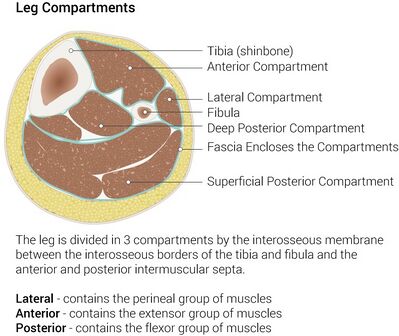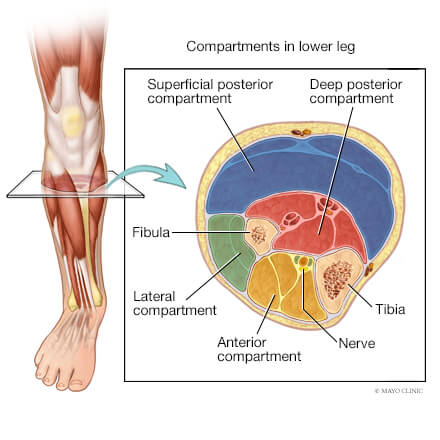Explain the Different Compartments of the Lower Leg
But it can also impact other parts of the leg as well as the feet arms hands abdomen belly and buttocks. Extensor digitorum longus extensor hallucis longus tibialis anterior anterior tibial artery anterior tibial nerve.

Muscle Compartments Of The Leg Uptodate
The strong osteofascial structures around the compartments prohibit and limit large volume increases of its contents.

. Describe the basic anatomy of the foot and ankle 26 bones of the foot tibia fibula. It is a continuation of the external iliac artery terminal branch of the abdominal aorta. Lateral fibular group which consists of fibularis longus and fibularis brevis.
Exercising in extreme heat. It includes the pectineus adductor magnus adductor minimus adductor longus adductor brevis and gracilis. The leg is divided into four osseofascial compartments by.
Studies have shown CECS is a common cause of lower leg pain in diabetic individuals 11 12. The posterior muscle group is the smallest group occupying the posterior compartment of the thigh. The first diagram summarizes the different muscular compartments fascial compartments of the thigh and leg and the different fascias crural fascia intermuscular septum interosseous membrane adductor canal fascia.
Pregnancy is another common cause of muscle cramps in the lower leg. This compartment contains the extensor muscles of the toes the tibialis anterior muscle the deep peroneal nerve and the tibial artery. The medial group occupies you guessed it the medial compartment of the thigh.
The anterior compartment of the legis the most common location for compartment syndrome. But each of our limbs has specific areas of muscle and physicians call those specific areas compartments And so for example doctors think of your lower leg as having four compartments. Innervation of the lateral compartment of leg superficial fibular nerve.
There are two kinds of compartment syndrome. Nerve or blood vessel disorders. On average pressures in the four.
Included in the anterior compartment is the deep peroneal nerve extensor digitorum longus tibialis anterior and extensor hallucis longus. Acute exercise-induced compartment syndrome of leg is defined as an acute compartment syndrome arising in the leg in the complete absence of any trauma or surgery in individuals without pre-existing risk factors for the development of the condition following athletic activity Of all the four compartment of leg anterior compartment is the most commonly. The lower leg buttock or thigh is usually involved.
Ankle joint is shaped like a mortise. Key Takeaways Anterior Compartment. In the femoral triangle the profunda femoris artery arises from the.
The numerous tributaries from bones tendons and muscles drain into a system of deep venous trunks. Are there different types of compartment syndrome. Thyroid or liver disease.
Several muscles are located in the posterior compartment of the leg typically grouped into. The external iliac becomes the femoral artery when it crosses under the inguinal ligament and enters the femoral triangle. There are also multiple conditions that may cause lower leg muscle cramps.
Acute compartment syndrome is usually caused by a bad injury and is a medical emergency. In the leg there are four muscle compartments. These compartments are generally referred to as the anterior lateral or peroneal deep- and superficial posterior compartment each with specific muscles vascular structures and nerves providing to the lower leg and foot.
Terms in this set 4 Anterior Compartment. Describe the vascular anatomy of the leg to explain why loss of the dorsalis pedis pulse can indicate anterior compartment syndrome. After all we dont tend to think of our bodies as say a large cabinet with different compartments for storing different items.
With this in mind we included persons with diabetes and CECS the PDC group to ensure the detection of a stiffer fascia. Abdominal compartment syndrome almost always develops after a severe injury surgery or during critical illness. In the lower leg each musculo-fascia1 compartment contains a set of.
The mean compartment pressure in the lower leg in children was significantly higher than in adults p 0001. Some conditions associated. Three muscles in the anterior compartment of the leg act to dorsiflex and invert the foot at the.
Extensor hallucis longus. Extensor digitorum longus. The fibrous tissue is very inflexible and cannot stretch to accommodate the generalized swelling.
The main artery of the lower limb is the femoral artery. If left untreated muscles and nerves fail and may eventually die. The deep veins of the lower extremity drain the structures under the deep fascia.
Compartment syndrome occurs most often in the lower leg. The myology of the lower limb is also particularly well represented in this atlas of anatomy with multiple anatomical charts and diagrams. Anterior lateral deep posterior and superficial posterior.
It is generally accepted that there are four compartments of the lower leg anterior lateral deep posterior and superficial posterior. Slide 62 in the lower limb lecture concerns a different test for strength of these muscles COA p. Ankle is two joints.
Anterior intermuscular crural septum. In the lower leg there are 4 compartments the anterior lateral deep posterior and superficial posterior. Posterior plantar flexor group which consists of a superficial layer comprised of the gastrocnemius plantaris and soleus and a deep layer comprised of tibialis posterior flexor hallucis longus popliteus and flexor digitorum longus muscles.
One possible explanation for tissue stiffening is the accelerated formation of the collagen cross-links called advanced glycation end products. These muscles are also called the adductors of the thigh. This creates distinct compartments.
Subtalar talus calcaneus and Crural joint tibia fibula talus. Muscles in the forearm lower leg and other body areas are surrounded by fibrous bands of tissues. Interosseous membrane of the leg.

Compartment Syndrome Of The Lower Leg Physiopedia

Exertional Compartment Syndrome Overview Mayo Clinic Orthopedics Sports Medicine
No comments for "Explain the Different Compartments of the Lower Leg"
Post a Comment